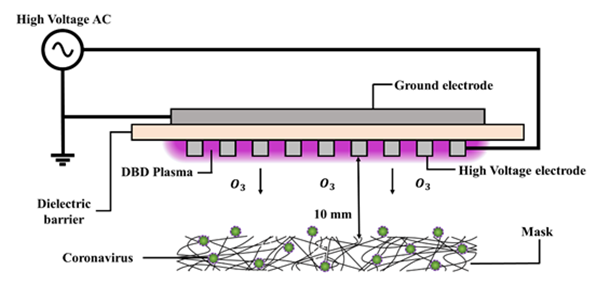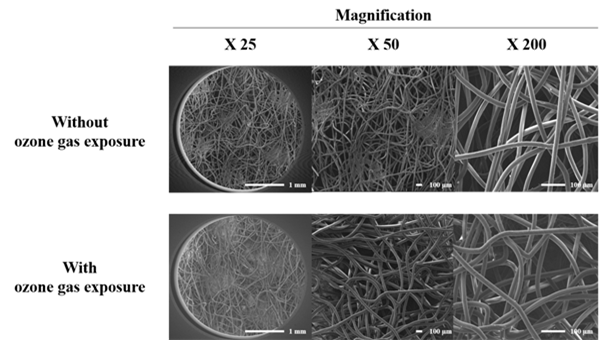Mechanical Engineering Professor Bak Moon Soo‧Professor Park SungSu's research team,
Develops Fast and Easy Disinfection of Coronavirus-contaminated Face Masks Using Ozone Gas
- Instant sterilization of coronavirus in 1 minute without sacrificing mask performance.
- Expected immediate use in countries with insufficient masks and medical sites requiring frequent replacement.
 [Image 1] A schematic diagram describing the disinfection of a face mask contaminated by a coronavirus using ozone produced by a DBD plasma generator.
[Image 1] A schematic diagram describing the disinfection of a face mask contaminated by a coronavirus using ozone produced by a DBD plasma generator.
DBD: dielectric barrier discharge.
Mechanical engineering professors Bak Moon Soo and Park SungSu's research team (Lee JinYeop, Bong Cheolwoo Ph.D.) reported that they have developed a technology that can be utilized in medical field: high concentration of ozone gases produced by plasma generators on masks contaminated with coronavirus can kill the virus in a minute without compromising the masks's performance at all.
After the Corona 19 outbreak, the researchers recognized that many countries were suffering from lakc of supply of N95 (Korea KF94) masks equipped with electrostatic filters and that the long-term use of contaminated masks also increased the infection of medical staff.
Researchers succeeded in suppressing infection 100% when the surface of coronavirus infected mask was exposed to disinfectant ozone gas for one minute at the level of 120ppm. It is expected to easily prevent mask contamination by not only coronavirus but other viruses and germs at medical sites.
The researchers conducted an experiment (five times per minute, 120ppm ozone gas exposure) on KF94 masks, and were verified by two national certification agencies for mask performance that the dust collection efficiency, which is the main performance of the mask, was maintained at 98%. In addition, the electrostatic filter structure of the mask was confirmed to be intact by using a scanning electron microscope. This means that masks can be recycled at least five times.
Ozone generators in the market are designed to sterilize space in the form of air purifiers. However, low-concentration ozone gases are unlikely to be effective against high-concentration viruses or bacterial sterilization. On the other hand, the team's treatment method uses low-temperature, upper-pressure plasma to generate 120ppm of high-concentration ozone gas only in the space where the mask is located to conduct sterilization. As ozone is generated for a short period of one minute, the amount is minimal, and the use of a plasma generator in a hood with good air circulation can prevent ozone-induced hazards.

[Image 2] The images were taken by a field-emission scanning electron microscope (SEM). Scanning electron microscopy images of the filter layer of uncontaminated face masks with and without exposures to ozone gas.
In addition, this technology can be easily applied to mask sterilization by domestic companies that produce plasma generators, and is expected to be able to pioneer the market for overseas exports through the process of optimizing ozone gas exposure to masks.
This study which conducted coronavirus infection test had the support of the Ministry of Science and ICT Global Frontier Project (Director Shin Yong-beom of the BioNano Health Guard Research Group) and the BICS (Biomedical Institute for Convergence)-KS (Kangbuk Samsung Hospital) Future Convergence Program
The results of this study was pre-published on Friday May 1st on MedRxiv, an internet site that distributes undisclosed manuscripts on health science for rapid dissemination of technology and the present paper is now under review for formal publication.
※ Thesis: Fast and easy disinfection of coronavirus-contaminated face masks using ozone gas produced by a dielectric barrier discharge plasma generator.
※ Thesis source: https://medrxiv.org/cgi/content/short/2020.04.26.20080317v1.
